ch 24: Electromagnetic Waves/Radiation
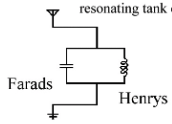

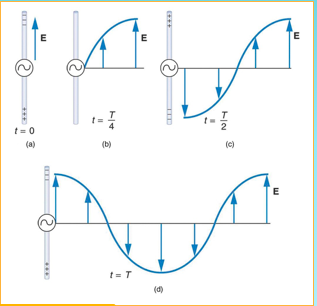


OK, NOW FOR THE FUN PART.....

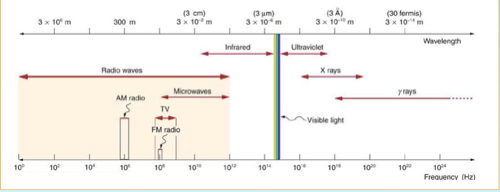
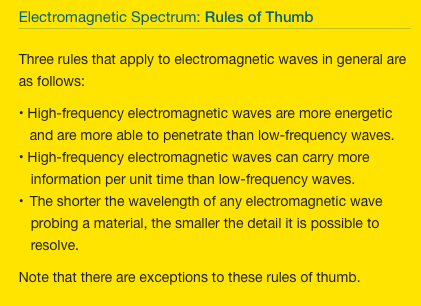
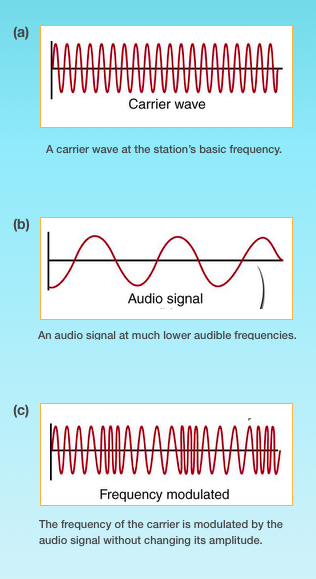

 for the E field version
for the E field version





LC circuits, radio
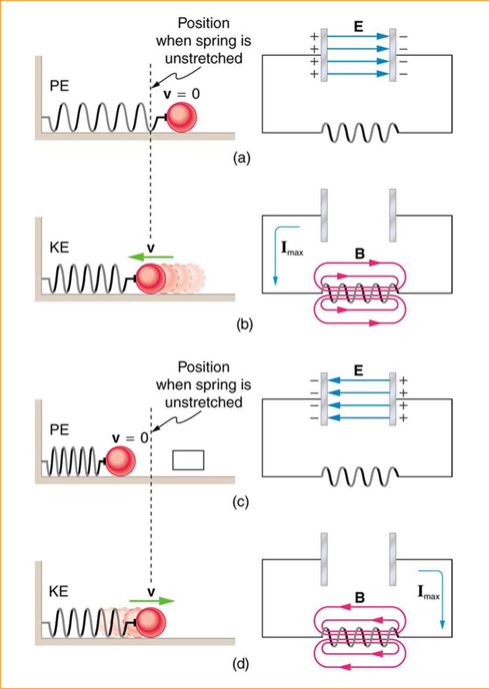


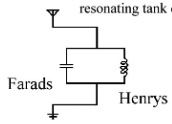

MAKE SURE YOU CAN DO THE FOLLOWING WITH THE SIMULATIONS:


Chapter 23 Induced EMF (finally)



emf = 2Blvsinwt
emf = NABwsinwt
Or, since emfo is NABw,
emf = emfo sinwt

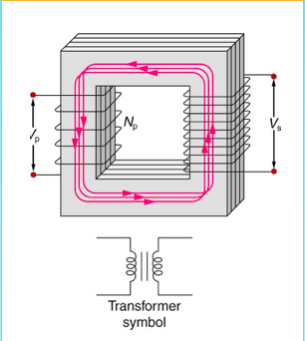





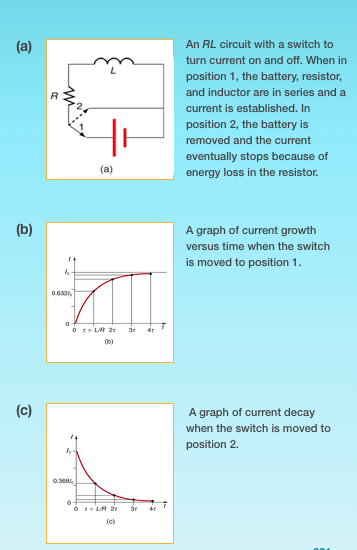







ibook ch 22 notes
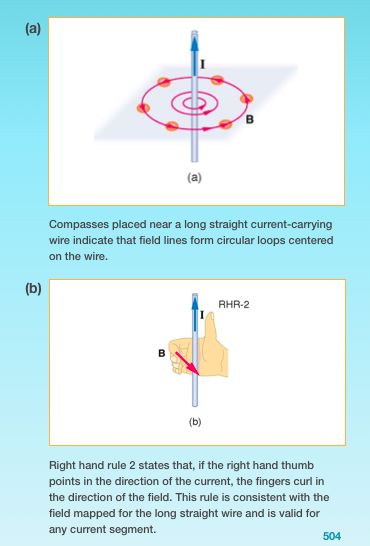

If the wire is in a loop:
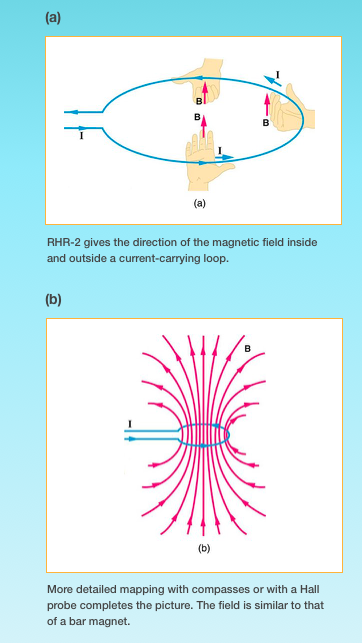

 Notice the next right hand rule: thumb is direction of current, fingers show the direction of the B field
Notice the next right hand rule: thumb is direction of current, fingers show the direction of the B field

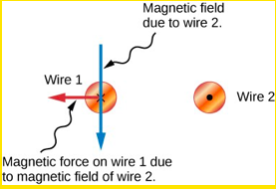



iBook ch 22 notes
- what is a CME? why should we care?
- what is EMP? how is it similar to CME? why should we care?
- ferromagnets vs. electromagnets
- dipoles vs. monopoles (theoretical)
- domains
- curie temp
- electromagnet: right hand rule around a loop
- magnetic field lines: B field
- Right hand rule: F= qvB(sin theta)
- more complex: cyclotron formula
Magnetism discussion questions
- Explain why sailors used magnetic compasses while the Arab voyagers did not. Hint: one travels on the desert.
- Look up the various ways modern airlines navigate. Why do they use one and not the other?
- Explain why we don’t see the Aurora Borealis in Hawaii, except when there is severe solar weather.
- Use the stream analogy to explain magnetic field lines.
Waves and sound lab
- Using the water tubes, measure the resonant length for three different frequency tuning forks.
- Calculate the speed of sound for each
- Average these
- Question: what would happen to the wavelength if the temperature rose?
- Using the slender springs, create a standing wave a few meters apart. Notice the frequency.
- Send a pulse along this stretched spring and measure the time it takes to travel from one end out and back. Calculate the velocity of the pulse.
- Using this velocity and the distance apart, predict the frequency you would need to shake the end to create a single standing wave.
- Repeat this for a double standing wave.
- Question: Otis is sitting on a dock in the bay (ha ha ha). He notices waves that are 10 meters apart. If these waves are traveling at 2 m/s, what is their frequency?
- Using the slinky, create a longitudinal wave pulse. Notice the time it takes to reach the other end.
- Calculate the longitudinal velocity of this wave.
- Using the same slinky, the same distance apart, calculate the velocity of a transverse wave.
- Are these similar or different?
- Question: longitudinal waves can go through solids or liquids. Transverse waves can only go through solids (ocean waves are a different case). Look up seismology online and find out how scientists know that parts of the earth are solid and others liquid.
Waves



Astro questions 4.9.13
Honors physics astro notes
Lab: Electrical equivalent of heat
- What was the power reading on the hot plate while you were heating the water? This is usually measured in Watts, or joules/sec
- What was the measured slope of the graph, in what units?
- At what rate was the electrical energy transformed into heat?
- Calculate the efficiency of the hot plate.
- What was the change in temperature for the water?
- How much energy was absorbed by the water?
- How many seconds did the microwave heat the water?
- How many Watts were used by the microwave oven?
- Multiply the Watts x seconds, this should be the number of joules
- How efficient is the hot plate?
Honor Physics Astro 1.0
Semester video projects
Physics Semester video project
Topics:
measurement
graphing
vectors and scalars
average velocity
position time graphs
accleleration
velocity-time graphs
freefall
drag
two dimensional motion
projectile motion
forces
F=ma
action= reaction
inertia
PE
Work
Power
KE
Spring energy
Work-energy theorem
momentum
impulse
collisions
circular motion
centripetal force
gravitation
satellites
Syllabus

Welcome to Physics/Physics Honors
Instructors
Jerry Bleckel, Greg McKenna, Dr. Bill Wiecking
jbleckel@hpa.edu, gmckenna@hpa.edu, bill@hpa.edu, physics.hpa.edu
The Course
Physics is an introductory survey course that covers everything in a traditional high school physics course. This year, we will study motion, forces, energy, matter, waves, electricity, magnetism and modern physics.
Text
Active Physics by Eksenkraft, Third edition. Publisher: It’s About Time, Herff Jones Education Division. The text can be found as a .pdf file at physics.hpa.edu. We will supplement this textbook with the excellent online site Khanacademy.org and other videos that can be found on YouTube.com. We will likely use this often to supplement the lectures in class.
What you’ll need to bring to class
scientific calculator other than your phone/tablet
3-ring binder for taking notes, storing handouts, etc. with lined paper
straightedge, colored pencils, other tools.
Classroom Procedures
1. On the way into class, pick up the daily worksheet at the desk nearest the door.
2. All cell phones and electronic devices need to be shut off and put away.
3. When the class begins, students are to be in their seats with their homework on the desk space in front of them. We will go over questions about the homework as well as any questions about the lectures.
4. During group work, students are expected to talk quietly with members of their own group.
5. When help is needed during a test, during seatwork, or during group work, students are to raise their hands for teacher assistance. While waiting, students should continue to try to answer the question on their own.
6. Tardy students must drop their tardy note on the desk as they enter.
7. When absent, students are expected to do the assignments in the syllabus except in unusual cases. It is expected that you will write or call me in such circumstances.
8. Questions of a personal nature, such as questions about points given for a particular assignment, should be brought up individually with the instructor before or after class.
9. If you lose handouts and other papers from class, it is your responsibility to make copies from other students. Papers from recent classes can usually be found in a folder by the door.
Engrade
On Engrade.com, you can find your grades, assignments, and quizzes. We will register for this the first day of school. Your parents will have the opportunity to access Engrade as well.
Grades and Exams
There will be “evening quizzes” each day there is homework. You can find the quizzes in your Engrade account. Check the calendar each day. They will be short, usually 3 multiple-choice questions.
We will have daily quizzes, usually at the end of each class period. These daily quizzes will be short and review the work done during the class period. The daily quizzes will first be scored using the following table:
|
Correctness |
Process |
|
C Complete |
J Justified |
|
E Small errors |
P partially justified |
|
I Incorrect |
N Not justified |
Once the daily quizzes are returned, you will have the task of correcting and explaining your mistakes for each problem. (If you receive a score of C/J no correction will be necessary). You will then give yourself a grade for the quiz and return it. I will either agree or disagree with your grade, and enter it in the Engrade grade book. Note: Daily quizzes may also be on the lab investigations. Students may NOT re-take quizzes. Be ready each day.
Formal Labs
You will most likely do one formal lab write-up each quarter, possibly two. They will be graded in the Correctness/Process format above.
Tests
Tests will be given at the end of each unit. Our tests will be based on practice problems that you will already have had a chance to master.
Grading Percentages
Evening quizzes 10%
Daily quizzes (including lab investigations) 10%
Labs (investigations) 10%
Lab formal write-ups 20%
TESTS 50%
Homework/Class Work
We’ll be trying something new this year. Your homework will mostly consist of watching short videos on khanacademy.org and doing a few “easy” questions as well as a complex question or two (once we are able). In class, we will review these videos, practice solving problems and/or do lab investigations. The Engrade homework/quizzes will be CLOSED by 8:30 a.m. the day of class to enable the instructor to view the results prior to class.
Honors?
As you may have noticed, our class is called “Physics/Physics Honors.” All five sections of the course will be treated the same. If you desire to take the challenge of Physics Honors, you will be required to design, create, and execute a science fair project in the fall and winter. In the spring, once the science fair is complete, we will move to another project, most likely astronomy. We will be meeting every Tuesday from 8 – 8:30 a.m. in room 41a. Our first meeting is August 28 in room 41a.
Emergency Procedures
In the event of an emergency, exit the room via either door and gather as a class at the bottom of the hill. Remain quiet and await further instructions.
Final Note
Messrs. Bleckel, McKenna, and Wiecking are all available to help any student, even if they are not your primary teacher.
